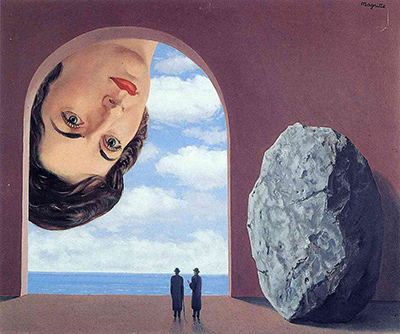Portrait of Stephy Langui
Portrait of Stephy Langui is a 1961 surrealist work, created by Rene Magritte.
Magritte was, and remains, one of the foremost figures in the world of surrealism. He was born in Belgium in 1898 and he died in 1967.
Portrait of Stephy Langui was thus painted during the high point of his career, when he had tried and tested his style and when his surrealist philosophy (which he expounded in his published writings from the 1920s onward) had been fully developed.
Like most of his works of art, Portrait of Stephy Langui is painted using the medium of oil on canvas, however Magritte also experimented with other media during his career, including lithographs.
Portrait of Stephy Langui belongs to what is usually designated to be Magritte's 'late period'.
In Portrait of Stephy Langui, we see Magritte playing around with the traditional portrait form. Instead of presenting us with a classic head and shoulders portrait of Langui, Magritte depicts a pair of small, silhouetted human figures beneath an arch, looking out towards a seascape.
Langui's giant, impeccably made up face looms, upside down through the arch, almost as if she is peering in to a doll's house. The effect is surreal: as with many of his works, Magritte evokes traditional forms and genres (in this case, portraiture) only to subvert them.
Viewers may well ask, just who was Stephy Langui? The short answer is, perhaps Magritte did not want her to be seen as a specific person but rather as something more sublime and symbolic.
In fact, this painting is sometimes just referred to as 'Portrait of a Woman'. Nevertheless, it is possible to decipher who Stephy Langui was. She was the wife of Emile Langui.
Like Magritte, Emile Langui was Belgian and he was a curator, art historian and prominent socialist. He battled to liberate Belgium from the Nazis, and he dedicated much of his life towards working to repatriate Belgian artworks that had been looted during the second world war.





